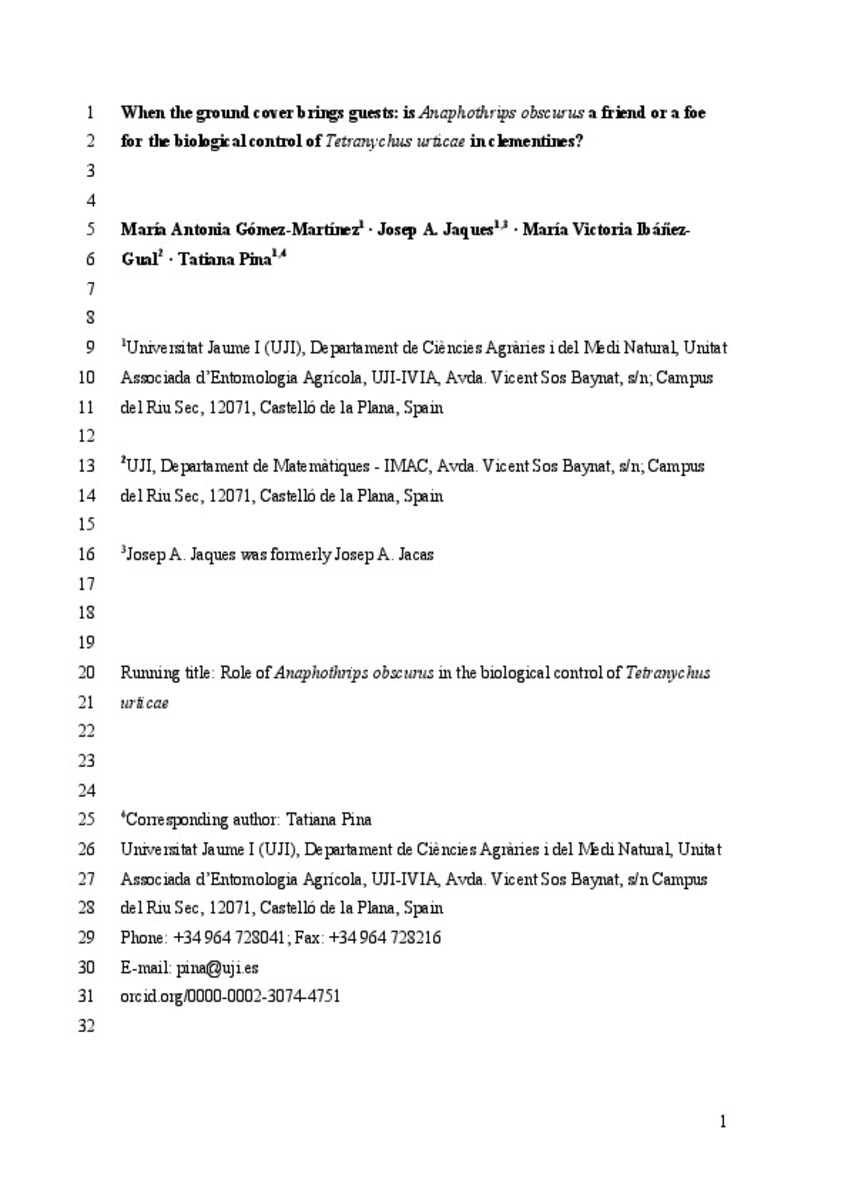Mostra el registre parcial de l'element
When the ground cover brings guests: is Anaphothrips obscurus a friend or a foe for the biological control of Tetranychus urticae in clementines?
| dc.contributor.author | Gómez-Martínez, María Antonia | |
| dc.contributor.author | Jaques , Josep A. | |
| dc.contributor.author | Ibáñez Gual, Maria Victoria | |
| dc.contributor.author | Pina, Tatiana | |
| dc.date.accessioned | 2017-12-14T12:14:48Z | |
| dc.date.available | 2017-12-14T12:14:48Z | |
| dc.date.issued | 2017-10 | |
| dc.identifier.citation | GÓMEZ-MARTÍNEZ, María Antonia, et al. When the ground cover brings guests: is Anaphothrips obscurus a friend or a foe for the biological control of Tetranychus urticae in clementines?. Journal of Pest Science, 2017, p. 1-11. | ca_CA |
| dc.identifier.uri | http://hdl.handle.net/10234/170942 | |
| dc.description.abstract | Biological control of Tetranychus urticae Koch (Acari: Tetranychidae), a key pest of clementines, can be improved in this crop with the establishment of a ground cover of Festuca arundinacea Schreber (Poaceae). This cover houses an abundant and diverse community of predatory Phytoseiidae mites including Euseius stipulatus (Athias-Henriot), Neoseiulus barkeri Hughes, Neoseiulus californicus (McGregor) and Phytoseiulus persimilis Athias-Henriot and a dense population of the grass thrips Anaphothrips obscurus Müller (Thysanoptera: Thripidae) throughout the year. The aim of this study was to determine whether the presence of this thrips species could be related to the improvement in the biological control of T. urticae. Therefore, the capacity of the abovementioned phytoseiids to feed and reproduce on A. obscurus and their feeding preferences when T. urticae and A. obscurus were simultaneously offered, were analyzed. The results show that E. stipulatus, N. barkeri and N. californicus have a type II functional response when offered A. obscurus nymphs, whereas P. persimilis barely feeds on this thrips species. Furthermore, N. barkeri and N. californicus can reproduce feeding only on thrips. Regarding prey preference, the Tetranychus spp.-specialist P. persimilis preferably preyed on T. urticae, the generalists N. barkeri and E. stipulatus preferred A. obscurus, and the selective predator of tetranychid mites N. californicus showed no preference. Therefore, we hypothesize that the enhanced biological control of T. urticae observed could be related to A. obscurus becoming an alternative prey for non-specialist phytoseiids, without altering the control exerted by the T. urticae-specialist P. persimilis and likely reducing intraguild predation. | ca_CA |
| dc.format.extent | 11 p. | ca_CA |
| dc.format.mimetype | application/pdf | ca_CA |
| dc.language.iso | eng | ca_CA |
| dc.publisher | Springer | ca_CA |
| dc.rights | © Springer-Verlag GmbH Germany 2017 | ca_CA |
| dc.rights.uri | http://rightsstatements.org/vocab/InC/1.0/ | * |
| dc.subject | Festuca arundinacea | ca_CA |
| dc.subject | Phytoseiidae | ca_CA |
| dc.subject | functional responses | ca_CA |
| dc.subject | prey preference | ca_CA |
| dc.subject | apparent competition | ca_CA |
| dc.title | When the ground cover brings guests: is Anaphothrips obscurus a friend or a foe for the biological control of Tetranychus urticae in clementines? | ca_CA |
| dc.type | info:eu-repo/semantics/article | ca_CA |
| dc.identifier.doi | http://dx.doi.org/10.1007/s10340-017-0926-0 | |
| dc.relation.projectID | Spanish Ministry of Science and Innovation (AGL2011-30538-C03-01) ; Bancaixa Foundation—Universitat Jaume I Research Program (P1·1B2012-15) | ca_CA |
| dc.rights.accessRights | info:eu-repo/semantics/openAccess | ca_CA |
| dc.relation.publisherVersion | https://link.springer.com/article/10.1007/s10340-017-0926-0#Abs1 | ca_CA |
| dc.type.version | info:eu-repo/semantics/publishedVersion | ca_CA |
Fitxers en aquest element
Aquest element apareix en la col·lecció o col·leccions següent(s)
-
MAT_Articles [759]
Articles de publicacions periòdiques -
CAMN_Articles [566]







